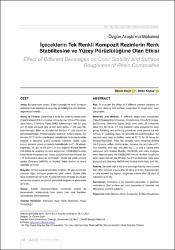İçeceklerin tek renkli kompozit rezinlerin renk stabilitesine ve yüzey pürüzlülüğüne olan etkisi
Künye
Erçin Ö, Kopuz D. İçeceklerin Tek Renkli Kompozit Rezinlerin Renk Stabilitesine ve Yüzey Pürüzlülüğüne Olan Etkisi. ADO Klinik Bilimler Dergisi. 2024;13(1):68-76.Özet
Amaç: Bu çalışmanın amacı, 5 farklı içeceğin tek renkli kompozit
rezinlerin renk stabilitesine ve yüzey pürüzlülüğüne olan etkisinin
değerlendirilmesidir.
Gereç ve Yöntem: Çalışmada 5 farklı tek renkli kompozit rezin
(Clearfil Majesty ES-2 Universal, Omnichroma, Vittra APS Unique,
ZenChroma, Charisma Topaz ONE) kullanılmıştır. Her bir grup
için 35 adet kompozit disk (2 mm kalınlığında- 7 mm çapında)
hazırlanmıştır. Bitim ve cila işlemleri Sof-Lex XT cila diskleri ile
gerçekleştirilmiştir. Polimerizasyon işleminin tamamlanması için
örnekler 37 °C distile suda 24 saat bekletilmiştir. Ardından örnekler
rastgele 5 deneysel gruba ayrılarak; kahvede, distile suda,
kırmızı şarapta, çayda ve kolada bekletilmiştir (n=7). Örneklerin
başlangıç, 10. gün ve 28. gün L, a ve b değerleri Konica Minolta
CM-3600A ile ölçülmüş ve renk değişimleri CIEDE2000 formülü
kullanılarak hesaplanmıştır. Yüzey pürüzlülükleri ise Mitutoyo SJ 410 profilometre cihazı ile ölçülmüştür. Veriler tek yönlü varyans
analizi (One-way ANOVA) ve Kruskal Wallis testleri ile analiz
edilmiştir (p<0.05).
Bulgular: Kırmızı şarapta bekletilen örnekler, 28 gün renklenme
sonunda diğer solüsyon gruplarına göre anlamlı ölçüde daha
fazla renklenmiştir (p<0.05). Kolada bekletilen örnekler ise 28 gün
renklenme sonunda en yüksek pürüzlülük değerlerini göstermiştir
(p<0.05).
Sonuç: Estetik restorasyonlarda renklenme önemli bir
parametredir. Materyallerin hem yüzey hem renk özellikleri
içeceklerden etkilenmektedir. Aim: To evaluate the effect of 5 different colorant solutions on
the color stability and surface roughness of single-color resin
composites.
Materials and Method: 5 different single-color composites
(Clearfil Majesty ES-2 Universal, Omnichroma, Vittra APS Unique,
ZenChroma, Charisma Topaz ONE) were used. 35 composite
discs (h:2 mm thick- d:7 mm diameter) were prepared for each
group. Finishing and polishing procedures were carried out with
Sof-Lex XT polishing discs. To complete the polymerization, the
samples were kept in distilled water at 37 °C for 24 hours for
postpolymerization. Then the samples were randomly divided
into 5 groups; coffee, distilled water, red wine, tea, and cola (n=7).
The baseline, 10th day, and 28th day L, a, and b values were
measured with Konica Minolta CM-3600A and color changes
were obtained using the CIEDE2000 formula. Surface roughness
were measured with the Mitutoyo SJ-410 profilometer. Data were
analyzed with One-way ANOVA and Kruskal Wallis tests (p<0.05).
Results: Samples kept in red wine were significantly more colored
than other solution groups after 28 days (p<0.05). Samples kept
in cola showed the highest roughness values after 28 days of
coloration (p<0.05).
Conclusion: Coloration is an important parameter in aesthetic
restorations. Both surface and color properties of materials are
affected by colorant solutions.
Kaynak
ADO Klinik Bilimler DergisiCilt
13Sayı
1Bağlantı
https://dergipark.org.tr/tr/pub/adoklinikbilimler/issue/82902/1290223https://doi.org/10.54617/adoklinikbilimler.1290223
https://hdl.handle.net/20.500.12780/792


















